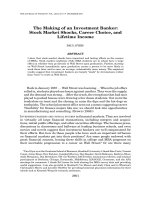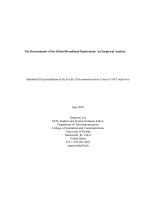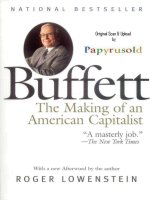The making of psychotherapists an anthropological analysis j davies (2009)mxmllACADEMIC
Bạn đang xem bản rút gọn của tài liệu. Xem và tải ngay bản đầy đủ của tài liệu tại đây (1.34 MB, 319 trang )
THE MAKING OF PSYCHOTHERAPISTS
AN ANTHROPOLOGICAL ANALYSIS
JAMES DAVIES
First published 2009
by Karnac Books Ltd.
118 Finchley Road
London NW3 5HT
© James Davies
The moral right of the author has been asserted.
All rights reserved. No part of this book may be reproduced or utilised in
any form or by any means, electronic or mechanical, without permission
in writing from the publisher.
British Library Cataloguing in Publication Data
A C.I.P. is available for this book from the British Library.
ISBN-13: 978-1-85575-656-4
www.karnacbooks.com
INTRODUCTION
11
create practitioners who will support and perpetuate the wider
psychoanalytic cause.
To say that trainees are influenced and transformed by these
powerful, external forces, however, is not to say that trainees have
no influence over their own transformations—for indeed many
trainees do resist the smooth and total assimilation of the psychoanalytic world-view. To invoke David Parkin’s (1995: 145) insight
for a moment—individuals find it difficult to completely convert to
new modes of meaning and thought, for old meanings and ideas
resist total disavowal and often re-emerge for re-integration.
However, those individuals in training who resist the unquestioned assimilation of psychoanalytic knowledge, and who to some
extent therefore assert their own vision of things, often encounter
institutional opposition. For these trainees there is a clear struggle
between the official practice that they are taught to adopt, and the
integrated practice that they might privately believe. For them the
knowledge that the institutes impart, instead of being assimilated
purely and completely, is often latticed or integrated with existing
knowledge to create something entirely new. Old knowledge that
resists complete
However,
those disavowal
individualscan
in therefore
training who
affectresist
and the
colour
unqueswhat is
tioned assimilation of psychoanalytic knowledge, and who to some
extent therefore assert their own vision of things, often encounter
institutional opposition. For these trainees there is a clear struggle
between the official practice that they are taught to adopt, and the
integrated practice that they might privately believe. For them the
knowledge that the institutes impart, instead of being assimilated
purely and completely, is often latticed or integrated with existing
knowledge to create something entirely new. Old knowledge that
resists complete
However,
those disavowal
individualscan
in therefore
training who
affectresist
and the
colour
unqueswhat is
tioned assimilation of psychoanalytic knowledge, and who to some
extent therefore assert their own vision of things, often encounter
institutional opposition. For these trainees there is a clear struggle
between the official practice that they are taught to adopt, and the
integrated practice that they might privately believe. For them the
knowledge that the institutes impart, instead of being assimilated
purely and completely, is often latticed or integrated with existing
knowledge to create something entirely new. Old knowledge that
resists complete
However,
those disavowal
individualscan
in therefore
training who
affectresist
and the
colour
unqueswhat is
tioned assimilation of psychoanalytic knowledge, and who to some
extent therefore assert their own vision of things, often encounter
institutional opposition. For these trainees there is a clear struggle
between the official practice that they are taught to adopt, and the
integrated practice that they might privately believe. For them the
knowledge that the institutes impart, instead of being assimilated
12
THE MAKING OF PSYCHOTHERAPISTS
In the end, in discussing psychotherapeutic training it goes
without saying that questions pertaining to the truth or falsity of
psychotherapeutic ideas are of anthropological interest only in so
far as what people believe (both inside and outside the community) has a bearing upon the social reality of the community itself.9 Thus the psychologist’s, intellectualist’s or philosopher’s concern about whether a given theory or belief is objectively true is replaced here with a phenomenological concern about the social significance of beliefs that are held to be ‘true’ (Kapferer 1983: xix). As
Mauss and Hubert tell us, ‘beliefs exists because they exist objectively as social facts’ (Hubert and Mauss 1981 [1964]: 101), implying
that the objective truth of a belief and the social consequences of its
being believed to be true are quite separate things. In this work I
am concerned with the social implications of a set of beliefs held to
be true, not with making epistemological or normative judgements
about their truth or falsity. 10 In fact, if this study offers critical comments at all, then these do not pertain to the ideas the profession
believes and expounds, but only to the institutions which purport
to protect, steward and transmit these ideas.
WHY THIS BOOK MATTERS
In this monograph, and within the broad parameters of the orientation outlined above, I wish to make use of an older and deeply insightful body of anthropological theory by applying it to this novel
contemporary context. With this method, rather than breaking with
traditional anthropological approaches, I seek to affirm the worth
of tested anthropological ideas by reworking them in the context of
a critical ‘repatriated anthropology’ (Gusterson 1996: 3). But before
I proceed to outline why I believe this book matters, let me first
provide a brief outline of each chapter in turn.
In chapter one I provide a history of the institutional development of psychotherapy in Britain, identifying three broad historical
trends that have influenced the state of the community today: the
expansion of psychotherapy during the twentieth century; the proliferation and stratification of training schools that has accompanied this growth; and the growing attack psychoanalytic psychotherapy has sustained during the last quarter of the twentieth century.
INTRODUCTION
13
In chapters two and three we move into the first stage of psychoanalytic socialisation: pre-training therapy (i.e. the personal psychotherapy all candidates undergo before entering the institute). In
short, we learn that the therapeutic encounter, like any ritual encounter, takes place in a bounded ‘psychotherapeutic frame’ which
delimits the spatial, temporal and relational dimensions of the session. We further learn how within this frame trainees come to imagine themselves and the world differently. This cultivation of a
‘psychoanalytic imagination’ constitutes a form of ‘institutional
vetting’ ensuring that only those who have taken to the therapeutic
experience self-select to proceed into the institute.
In chapter four I show how the ‘psychoanalytic imagination’ is
appealed to within the institutes to legitimate the training they offer. By studying the next phase of training, the seminar encounter, we
will see how status imbalances within institutes are legitimated by
analytic ideas, and how the transmission of ‘text-based’, ‘secret’,
and ‘personal’ knowledge shields this knowledge from criticism. In
short I argue that the educative atmosphere in seminars is by and
large more ‘affirmative’ than ‘critical’, more ‘sectarian’ than ‘academic’.
In chapter five we focus on how institutions manage trainee
dissent, describing how trainees are taught to direct their doubts
away from the system (the ideas) and onto other receptacles (patients, outsiders, competitors). I then illustrate through selected
case studies instances where trainee doubt, being unsuccessfully
redirected, settles on the paradigm itself causing ‘dissent’ from the
orthodox position. How dissent has been managed historically by
the institution provides insight into why the community lies in a
fractured state today.
In chapter six we turn to the next phase of training—clinical supervision, focusing especially on the psychoanalytic understanding
of aetiology. By analysing an extended case study (‘the case of
Arya’), and the socio-historical biases shaping Freud’s early thinking, I illustrate how and why the analytic understanding of aetiology can be seen as limited. I further show how such aetiological
assumptions are subtly affirmed in clinical supervision, leading
practitioners to treat patients in predictable ways.
In chapter seven we will see how covert institutional pressures
make trainees susceptible to the instruction on offer. By linking the
14
THE MAKING OF PSYCHOTHERAPISTS
ordeals and stresses of socialisation to trainees’ dependency on
seniors, we find that the social conditions of the institute covertly
render trainees susceptible to embodying the commitments, preferences, and the expansive ideology that seniors embrace.
Finally, in chapter eight I reveal that the psychoanalytic habitus
not only supports a species of clinical practice, but a way of life.
Here we acknowledge three ‘projects’ that the psychoanalytic myth
supports: the ethical, the political, and the communal. By analysing
the core values analytic training inculcates, and by exploring the
profound personal meaning therapy comes to have for practitioners, I provide the background against which the deeper significance of training can be revealed—initiation into a ‘selfredemptive’, socio-political movement of wide social aspiration
and influence.
In all chapters I make use of a wide variety of anthropological
concepts to illuminate the core stages of therapeutic training. In
this sense my work is less a ‘case-study’ showing where existing
anthropology is mistaken, than an ‘example’ of how existing anthropological theory can unravel social phenomena in the psychotherapeutic context. In Jeremy MacClancy’s (2002: 11) phrase, I
‘study up’ with anthropological insights in hand, showing how individuals are socialised into systems of meaning that support and
which are refracted in the community’s social structure. In other
words, I show how institutes can train individuals to recreate and
sustain the social structures of the community itself.
Applying the anthropological imagination to the psychotherapeutic context, along with contributing to the growing ethnographic record of professional socialisation, I offer a novel perspective on
certain problems afflicting the psychotherapeutic profession itself.
Many psychotherapists have traditionally sought to understand
the fracturing and inter-rivalry within their own community by
means of psychoanalytic ideas. To use Needham’s phrase, such
psychotherapists have reverted to a theoretical ‘psychologism’ to
analyse community dynamics: applying ideas devised to study individuals to investigate social life and institutions. In this sense
they mistakenly by-pass what sociological or anthropological theory could tell us about their social and community dynamics.
For instance, Cremerius (1990: 125) explains the inter-school
rivalries that beset the profession in terms of unresolved Oedipal
INTRODUCTION
15
rivalries. ‘To the extent to which [they] remain unresolved,’ says
Cremerius, ‘intellectual powers are eroded and hate, jealousy and
phallic rivalry define the relationships within the association
(p.125). Lousada (2000: 470), alternatively, suggests that the inability of psychotherapy schools to create working partnerships is due
to their inability to form libidinal cathexis if such cathexis could
take place then partnership might ensue. Frattaroli (1992: 132-42)
argues that psychotherapy’s history of schism and factionalism is
due to the institutionalisation of an internalised split Freud never resolved between the contradictory views that neurosis is primarily
intra-psychic (repressed drives) or inter-psychic (insufficient relationships). If this split could be reconciled then these divisions
might fall away. While Bruzzone et al (1985: 411), stress that the regression students experience in their therapy (making them use
words such as ‘mummy’ and ‘daddy’ to refer to their therapists,
and use phrases such as a ‘good feed’ to refer to a good training experience) is replicated during their training in the institute. Students then may feel persecuted and paranoid in the institute just as
they might in therapy when in regression. Finally, Figlio (1993: 326)
argues that because trainees internalise key figures—such as the
therapist and the institute—when they encounter others holding
onto different (often opposing) internalised figures a mutual hostility ensues.
I could continue to pile up many more examples of how community dynamics have been explained by psychotherapists in
terms of psychoanalytic concepts.11 This fact tells us not only
something about the community in question, but that therapists
themselves, as so many expressed to me, hold deep concerns about
the warring and fractured state of their profession; an institutionalised rivalry not only impeding the process of statutory regulation,
but also the cross-fertilisation of ideas necessary for theoretical development and reform, and—one might add—improved practice.
Not all therapists, of course, have resorted to explaining community dynamics in terms of psychoanalytic ideas. Some have understood wider tensions in more practical terms of how candidates
are selected and trained (Cremerius 1990; Kleinman 1998); and
how creativity is discouraged in training institutes (Kernberg 2006,
1996). Indeed, in recent years a new body of literature has proposed reforms to psychoanalytic education more broadly (Gaza-
16
THE MAKING OF PSYCHOTHERAPISTS
Guerrero 2002a, 2002b; Kernberg 2006; Levine 2003; Mayer 2003).
This literature is unified in suggesting that many of the problems it
believes the community now faces (diminishing creativity, ongoing
conservatism and interschool rivalry) must be challenged at the institutional level either by divesting self-interested groups of any
legal authority to define what is legitimate or illegitimate practice
(Whan 1999: 312); by introducing openness, pluralism and authenticity into training institutes (Samuels 1993); by diversifying and
broadening the curriculum to facilitate in candidates better empathetic and introspective perceptiveness (Berman 2004; Samuels
1993); or by establishing institutional mechanisms by which the
power of executive and educational committees can be devolved
(Kernberg 2006). Strategies such as abolishing the traditional training analysis (Mayer 2003), undermining retrogressive dependency
upon the theoretical faiths of the past (Garza-Guerrero 2002b), developing more objective criteria for training assessment (Tuckett
2003), and strengthening the intellectual, scholarly and research
context within which psychoanalytic education takes place
(Auchincloss & Michels 2003), have all been championed as possible remedies to the demise of creativity in the institutes, and to
the rise and entrenchment of rivalrous relations between different
psychotherapeutic schools.
While this project is not directly about making sense of such
problems and the rivalries as well as the entrenched positions they
engender, it is my belief that an anthropology of psychotherapeutic
socialisation can bring fresh light to old troubles while avoiding
being prescriptive or normative. Anthropologists have long known
that much human conduct is orientated to, and shaped by, the demands and pressures of the environments in which people find
themselves. If institutes harbour definite expectations in relation to
which trainees must organise their behaviour and professional
aims, then what these expectations demand of trainees (either
openness or antipathy toward ‘other’ schools) will influence how
they act as professionals, and finally whether the community will
move towards a more creative pluralism or simply remain in its
fractured state. Indeed, if change is to occur in the community then
what may require alteration are the circumstances and situations
people have to contend with. ‘[I]f this were done’, as Becker has
stated, ‘students would probably adapt to the changed situation
INTRODUCTION
17
and develop quite different kinds of perspectives’ (Becker et al
2002: 442). What Becker, Samuels, Sinclair, Luhrmann and others
have shown is that any kind of community reform must start with
a deep reflexive inspection of the sites or places where the community’s values, practices and beliefs are transmitted and sustained—and in so far as this study comprises such an investigation
it may thus indirectly inform and contribute to the unravelling of
these social problems.
PSYCHOANALYTIC / PSYCHODYNAMIC PSYCHOTHERAPY EXPLAINED
Before discussing my fieldwork methods, I would first like to
identify the exact kind of practitioner and training upon which my
research is focused. The most obvious confusion I must first anticipate concerns the differing roles of psychologist, psychiatrist, and
psychotherapist. A psychologist is someone whose professional life
involves researching and applying psychology (e.g. in the different
fields of education, forensics, criminality, etc.). Psychological theories charter different aspects of mental life such as cognition
(memory, perception, learning), and behaviour (social and individual). Thus psychologists are not clinicians. If they see patients at
all they only do so if they have submitted to an additional doctoral
or postgraduate training in clinical psychology, in such instances
they are referred to as ‘clinical psychologists’.12 Psychiatrists, on the
other hand, are medical doctors who specialise in diagnosing and
treating mental illness. They concentrate mainly on pharmacological intervention. Like psychologists, some psychiatrists have had an
additional psychotherapeutic training, usually at one of the independent psychotherapeutic institutes that I have studied here, but
most have only a rudimentary training during their own psychiatric residency. As to how much psychotherapy psychiatrists study
and employ is largely at their own and their supervisor’s discretion, although psychiatric departments now insist that trainees undertake some form of psychotherapeutic instruction during their
residency.13
To turn now to the psychotherapist, he or she is a clinician who
is usually a trained member of a psychotherapeutic training body
recognised by one of the two major accrediting bodies: the BPC
(British Psychoanalytic Council) or the UKCP (the United King-
18
THE MAKING OF PSYCHOTHERAPISTS
dom Council for Psychotherapy). A psychotherapist need not be a
psychiatrist or psychologist, and the majority of psychotherapists
are neither, although all must have some form of undergraduate or
‘equivalent’ experience (i.e. in nursing, social work, or teaching
etc.). The fact that the British psychotherapeutic field is wide, diversified, and unpredictably protean, comprising myriad schools
and contending traditions, makes the term ‘psychotherapist’
greatly unspecific. It denotes an array of practitioners from ‘psychoanalysts’ to ‘cognitive behavioural therapists’ to ‘humanistic
therapists’ and ‘existentialist therapists’. In Britain alone there are
eight traditions of psychotherapy recognised by the UKCP, each one
comprising an assemblage of varying schools. With this tangle of divergent forms it is crucial to define the precise kind of psychotherapy upon which my research will chiefly focus. Broadly put, I focus on the training and practice of practitioners within the psychodynamic or psychoanalytic tradition which is by far the largest and
most established psychotherapeutic tradition in Britain.
‘Psychodynamic’ psychotherapy is the term I shall use in this
book to characterise all those psychotherapies stemming from
Freud’s original teaching. Under the rubric of ‘psychodynamic
psychotherapy’ I shall include ‘psychoanalytic psychotherapists’ and
‘psychoanalysts . Thus in this book I shall uses the terms ‘psychodynamic’ and ‘psychoanalytic’ interchangeably. Psychoanalysts can
be distinguished from all other psychodynamic psychotherapists
in Britain by virtue of being trained at the Institute of Psychoanalysis.
The term ‘psychoanalyst’ then, in Britain today, denotes an institutional affiliation rather than a species of psychotherapy distinct
from other psychodynamic forms. Where psychoanalysis is most
obviously distinct clinically is in requesting that its trainees (and
often patients) submit to five-times-weekly analysis (a practice
which is supposed to facilitate a ‘deeper’ analysis), while other
psychoanalytic and psychodynamic trainings request only threetimes-weekly contracts or less. The social significance of these distinctions, and there are many, I will return to at a later point.
The mainstream tradition of psychodynamic or psychoanalytic
psychotherapy includes the great pioneers of psychotherapy such
as Sigmund Freud (1856-1939), Carl Gustav Jung (1875-1961),
Melanie Klein (1882-1960), Karen Horney (1885-1952), Donald Winnicott (1896-1971), Jacques Lacan (1901-81) and Erik Erikson









